Answer these simple questions and we will find you the BEST prices
Which type of solar quotes do you need?
It only takes 30 seconds
100% free with no obligation

Get up to 3 quotes by filling in only 1 quick form

Slash your energy bills by installing an energy efficient boiler

We’ve helped over 500,000 homeowners reduce their carbon footprint
- GreenMatch
- Blog
- How To Bleed A Radiator
Solving Heating Issues: How To Bleed A Radiator

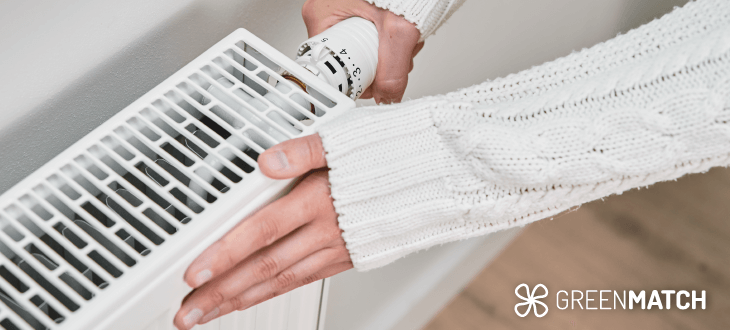
Are you struggling to keep your house warm? It could be time to bleed your radiators! Many of us go about our day without considering our radiator health, but when it becomes time to warm up our homes and find the radiators are cold, it can leave us uncomfortable and frustrated.
With 95% of homes in the UK relying on central heating to stay warm, keeping our radiators well-maintained is essential. Not only does it keep our temperatures cosy, but it also improves their efficiency, which can lead to lower energy bills (win-win!).
If you’re wondering how to keep your central heating working perfectly, we can help. In this article, we’ll talk you through bleeding your radiators, why it’s important and the easy step-by-step process you can do yourself. We’ll also look at the causes of cold radiators and how you can keep them in peak condition.
Bleeding a radiator
What is meant by ‘bleeding a radiator’? Well, it’s not as gruesome as it sounds!
Our radiators work by circulating hot water - this comes directly from the boiler through our pipes, and once it’s run through our radiators, it then flows back to the boiler to reheat. During this journey, air can get trapped in the pipework. The radiator must release this air (or ‘bled’).
Trapped air in your radiator will usually rise to the top, and as this air can’t be heated, it leaves a cold area at the top of your radiator. This is one clear way to identify when a radiator needs bleeding.
Bleeding a radiator involves releasing the valve (found at the top side) with a special key or tool, just enough to let the air escape. This allows your radiator to fill with water again, resolving any cold spots.
Call the Emergency Gas Line immediately at 0800 111 999 if you smell gas. Exit the property and wait for advice from the emergency services.
Signs your radiator needs bleeding
You should be able to easily identify when your radiators need bleeding. Below are some of the tell-tale signs to look out for.
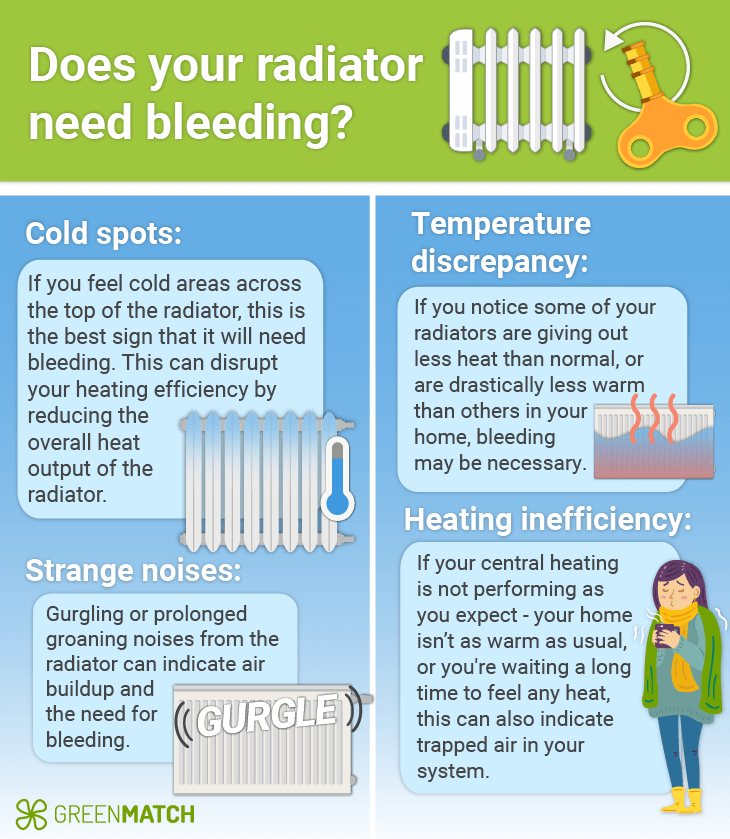
It's recommended that you bleed radiators regularly, ideally every couple of months, to ensure they function efficiently. This can help prevent large pockets of air building up, and help maintain peak performance.
If you encounter any of these problems, it’s worth trying to bleed your radiator to see if the issue resolves. If it doesn’t help, there may be a larger issue with your heating system in which case you should consult a qualified engineer to address any problems.
Experiencing bigger issues within your overall system? No hot water or strange sounds coming from your boiler? You should contact a professional heating engineer for help as soon as possible. It’s possible you need a larger repair or boiler replacement.
Step-by-step guide to bleeding a radiator
Bleeding your radiators is a quick, simple process that should offer great benefits. To get started, follow our step-by-step instructions below.
First - gather your tools! Having everything you need to hand is important before you begin.
You will need:
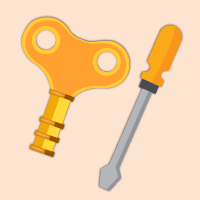
A radiator bleed key or flat-head screwdriver
This is essential for opening the radiator bleed valve. A radiator key is specifically designed for this purpose and they all come in the same size. However, a flat-blade screwdriver can also work for certain types of bleed valves if you don't have a key handy.
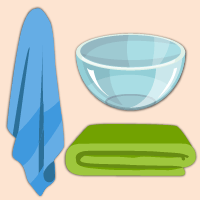
Cloth or towel
Have a cloth or towel handy to catch dripping water or protect the surrounding area from spills.
Container
Keep a small container or a rag nearby to catch any water that may come out while bleeding the radiator.
Step-by-step guide:
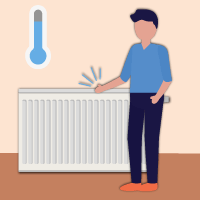
Step 1: Identify radiators that need bleeding
When your heating is on, carefully check each radiator for cold spots at the top. You only want to bleed radiators which show signs of trapped air.
Note - if your radiator is cold at the bottom but warm at the top, it doesn’t need bleeding. This is likely caused by a blockage or build-up of ‘sludge’ within the radiator. This can often be corrected by cleaning out your radiator or having a whole system ‘power flush’ undertaken. This is something an engineer can help with.
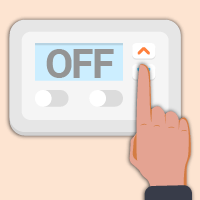
Step 2: Turn off the heating system
Next, ensure that your central heating system is turned off. This will allow the radiator (and the water inside) to cool down, reducing the risk of burns and minimising water leakage when you open the bleed valve.
Step 3: Identify the bleed valve
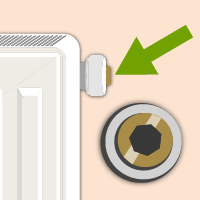
Locate the bleed valve on the radiator. It's usually located at the top, on one of the sides. The bleed valve is a small, square peg or a round knob, and it may be concealed under a plastic cap.
Step 4: Prepare the area
Place a small bowl or towel below the radiator to catch any water that may spill during the bleeding process. Hold another cloth or towel directly below the valve as you do the next step.
Step 5: Use the radiator key or screwdriver
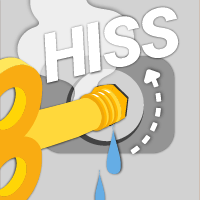
Insert the radiator key or screwdriver into the bleed valve and slowly turn it anticlockwise. You should hear a hissing sound as the air escapes. Keep the valve open until the hissing stops and water drops start to flow out.
Step 6: Close the bleed valve
Once the water appears, quickly close the bleed valve by turning it clockwise. Be careful not to overtighten, though, as this can damage the valve.
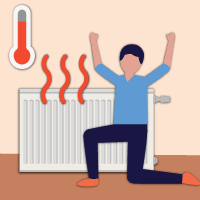
Step 7: Bleed all affected radiators
Now you have the hang of it, move on to the next affected radiators until you’re satisfied they are all done. You can now turn your heating back on and enjoy fully functioning heating!
Benefits of bleeding radiators
Ensuring that your central heating system is well-maintained and that your radiators are bled means you can enjoy a range of immediate and long-term benefits.
Maintaining an efficient heating system can also have several environmental benefits. These include:
1. Reduced carbon footprint: Energy-efficient boilers and heating systems can help reduce carbon emissions, contributing to the fight against climate change.
It’s estimated the average household generates around 2,690kg of carbon dioxide (CO2) just through space and hot water heating. If the UK were to hit net zero emission targets by 2050, each household would need to lower this figure by 140kg.
Keeping your heating system running efficiently can contribute towards lowering your emissions and supporting the country's goal of lower emissions.
2. Conserving natural resources: By using less energy, efficient heating systems reduce the need for finite resources like natural gas or oil, helping to preserve them for the future.
3. Improved air quality: Energy-efficient heating systems can improve air quality, as they produce fewer harmful emissions than traditional heating systems.
4. Renewable energy use: If you want to enhance your heating system further and reduce your environmental impact, you could replace your boiler with a low-carbon system or power your boiler with renewable energy. Some examples include solar panels for clean electricity or a heat pump for zero-emissions heating.
Common radiator problems
There can be several reasons that your central heating can let you down. Whilst some are easily fixed with actions like bleeding a radiator, some are often more complex and require the help of professionals.
Understanding the difference between common radiator problems can help you avoid unnecessary delays in resolving the issue. Below are some of the most frequent problems, with their solutions.
1. Air in the Radiator
Signs: Cold spots at the top, cold radiators, or unusual noises.
Solution: Bleeding the radiator is the most common and simple fix for trapped air. However, if the bleed vent is damaged, it should be replaced for optimal performance.
2. Sludge Build-Up
Signs: Cold spots at the bottom and reduced heating efficiency.
Solution: Sludge accumulation caused by corrosion deposits can hinder the radiator's performance. Flushing the radiator to remove the sludge is necessary. While this task is relatively simple, seeking professional advice is recommended for more complex issues or complete system flushing.
Adding a boiler filter to your central heating system can help prevent future build-up by capturing debris.
3. Boiler / Radiator Sizing Issues
Signs: Fluctuating temperatures in the room.
Solution: If your boiler is not powerful enough, it may be unable to heat the number of radiators in your home. Having inappropriately sized radiators can also cause a similar problem. Consider professional advice to ensure your system is adequate for your needs.
4. Leaking Radiator
Signs: Water leakage from the pipework or connections, consistently losing boiler pressure.
Solution: For minor leaks from loose nuts, using a wrench to tighten them may suffice. However, if significant leakage persists, it might indicate a more serious issue, necessitating professional intervention. Leaks caused by corrosion may require the replacement of the radiator.
If you’re experiencing ongoing low pressure from your boiler, you may have a leak somewhere in your pipework. Always consult a professional before attempting any work on a boiler.
Seeking professional help and advice
Radiator issues can significantly impact the efficiency of your heating system. Understanding and addressing common problems promptly is essential to maintain a comfortable and energy-efficient home.
Furthermore, with the cost of living crisis impacting energy bills, ensuring the efficient operation of your heating system is crucial. Seeking professional help for comprehensive system checks, maintenance, and repairs can prevent further damage and contribute to long-term energy and cost savings.
While some radiator issues can be resolved with DIY measures, larger problems such as sludge accumulation or leaks may require professional expertise. Finding an engineer you can trust, on a budget can be a challenge. Trawling through customer reviews and waiting weeks for callbacks can be frustrating - so why not choose the easy option?
Filling in our quick and easy form can connect you with up to 3 heating experts in your local area, who can offer free, no-obligation quotes for you to compare. It’s simple, and straightforward and gets you the help you need quickly. To get started, simply click the link below.
- Quotes from local engineers
- Payment by finance available
- Save up to £975
It only takes 30 seconds



Frequently asked questions
No, you should always turn your heating off before you begin. This ensures you avoid any risk of scalding from hot water in the radiator. Follow our step-by-step instructions for a safe and easy process.
Once water appears, you should quickly close the radiator bleed valve. Releasing too much water will result in your boiler pressure dropping. This can be fixed, but should be avoided as it can lead to other problems.
No! As soon as any water appears, close the valve. Bleeding a radiator is only done to remove trapped air from your system, so there should be very little water involved.
Use a flat head screwdriver, or any tool which can help you easily unscrew and tighten the valve. Just remember to follow each step carefully and never over tighten the valve.
If you feel a cold area at the top, but warmth at the bottom, this can indicate trapped air in your radiator. There are other common signs however, including inefficient heating or strange noises.

Becky is an experienced SEO content writer specialising in sustainability and renewable trends. Her background in broadcast journalism inspires reliable content to help readers live more sustainably every day.
We strive to connect our customers with the right product and supplier. Would you like to be part of GreenMatch?




